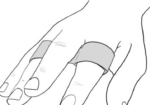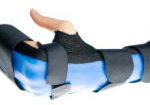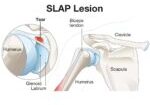DRUJ Instability and Hand Therapy Interventions
The distal radial ulnar joint (DRUJ) is the joint consisting of the distal radius and ulna which is held together by the ligamentous structure known as the TFC. DRUJ instability can be acute or chronic in nature. An acute injury is usually addressed by placing the patient in a long-arm cast for 6 weeks. In chronic cases, this becomes a much more complex issue and the severity depends on the reason for the chronic instability.

Conservative management of chronic DRUJ instability is often times the first line of treatment as the surgical procedures can be invasive and outcomes can vary. If an individual is very active surgical intervention is more likely to be indicated. However, a trial of therapy can be beneficial in determining if surgical intervention is needed to repair the DRUJ injury.
Functional Splinting
Conservative DRUJ injury treatment typically consists of functional bracing and is often key to successful management. You can test the stability of the joint by first applying a dorsal pressure over the ulna and a volar force on the radius. While holding the pressure over the ulna and radius, take the patient through forearm rotation. If the patient reports less pain, this is an indication they should be splinted with a dorsal pressure over the ulna and volar pressure over the radius. However, if this causes more pain, the opposite should be tested. A volar pressure should be placed over the ulna and a dorsal pressure over the radius. If there is no pain with forearm rotation, then splinting should replicate the pressure.
Therapy Interventions
When treating these patients it is very important to respect their pain as well as avoid exacerbating the symptoms. Yes, the structures can be stressed to facilitate healing however it is important to manage the stress in a slow controlled manner. Therefore having an understanding of the instability pattern and stage of injury is key to DRUJ injury treatment. It is important to keep exercises simple, once they can be performed within a pain-free range advance the patient to more challenging exercises.
Common DRUJ Injury Treatment Interventions
- Edema management techniques
- Contrast bathes for managing inflammation and pain
- Pain-free range of motion including forearm rotation, if this is painful the functional splint can be utilized while performing ROM. If still painful can begin range of motion in the dart-thrower plane.
- Isometric strengthening of PQ and ECU
- Proprioceptive exercises advance from the joint position in space with replication to more advanced activities such as tossing a ball/disc stacker

- Once again only advance the patient if they are tolerating well and there are no exacerbation of symptoms can continue to advance with all exercises.
Treating DRUJ instability is tricky and varies based on the extent of the pathology.
Zhiqing, C. (2018) A novel staged wrist sensorimotor rehabilitation program for a patient with triangular fibrocartilage complex injury: A case report. Journal of Hand Therapy, 32, 525-533.
https://www.jhandtherapy.org/article/S0894-1130(17)30404-0/fulltext
More To Read
Which orthosis design is better for zone 5-6 extensor tendon injuries, a relative motion orthosis compared to a dynamic extension orthosis?
M. Buhler, ˝ D. Gwynne-Jones, M. Chin et al., (2023) Are the outcomes of relative motion extension orthoses noninferior and cost-effective compared with dynamic extension orthoses for management of zones V-VI finger extensor tendon repairs: A randomizedcontrolledtrialJournalofHandTherapy. The Skinny: The aim of this study was to compare the data for two different types of orthoses…
Read MoreFlexor tendon rehabilitation in the 21st century: A systematic review
Neiduski, R. L. & Powell, R. K. (2019). Flexor tendon rehabilitation in the 21st century: A systematic review. Journal of Hand Therapy, 32, 165-174. The Skinny The objective of the study was to determine if there was evidence to support 1 type of exercise regimen. Exercise regimens reviewed include place and holds, early passive or…
Read MoreHand Pain in Pregnancy and the New Parent
By: Rachel Reed The transition to parenting can be difficult on a mother or parent’s body, especially when considering the increase in repetitive hand use required to care for a baby. The most common upper extremity conditions that develop during pregnancy and postpartum are carpal tunnel syndrome and de Quervain’s tenosynovitis (Wagner, 2019). Frequently, new…
Read MoreWhat is a Slap Tear? Superior Labrum Anterior to Posterior Tear
What is a SLAP injury?A Superior Labral, Anterior and Posterior (SLAP) lesion is an injury effecting the superiorportion of the glenoid labrum where the long head of the biceps tendon is anchored (Levasseur etal., 2021). The tearing commonly occurs posteriorly and extends anteriorly at the mid-glenoidnotch which can be examined through shoulder arthroscopy (Kim et…
Read MoreSign-up to Get Updates Straight to Your Inbox!
Sign up with us and we will send you regular blog posts on everything hand therapy, notices every time we upload new videos and tutorials, along with handout, protocols, and other useful information.






